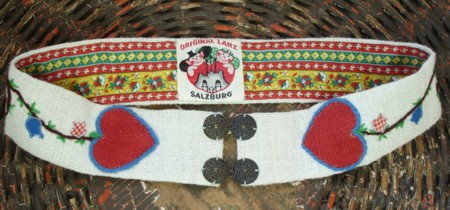
Photo found on Wikipedia
I have a really short attention span. I can’t blame my age because I’ve always been this way. I’ll be interested in one thing and then in my pursuit of it notice another, and so off I go in that direction. I think that is why I like writing this blog. I can chase whatever rainbow crosses my sky.
I might have mentioned here that I’m working on a program about women’s camp and hiking attire. Since I was doing the work anyway I decided to expand the research in order to write a paper for possible presentation or publication. And the topic is so interesting to me that I thought I’d have little trouble staying on track.
Wrong. Everywhere I turn there I see another route I want to take, another fascinating fact to share, another article to read and think about. And it is funny how when a topic gets into the consciousness, related topics tend to pop up as well.
Last week I went to the Metrolina Marketplace for a bit of recreational treasure hunting. A women had her half-grown puppy there, and she was really making a spectacle of herself – the dog, not the owner. This was a dog who knew how to command a crowd, and she was working the flea market with a very skilled paw.
Turns out the dog is a Coton de Tulear by the name of Coco Chanel. The Coton de Tulear is a fairly rare breed, and I’m sure the owner chose the name because it symbolized glamour and fashion to her. Frankly, I’d never name an animal for a notorious Nazi-lover, and it occurred to me that people must either not care that Chanel was such an odious person (her words, not mine), or they don’t actually know much about her.
But the encounter with the sweet dog with the sadly inappropriate name must have put Chanel in the forefront of my thoughts, because I keep finding her in my reading.

One of my finds from the weekend was a 1909 issue of McCall’s Magazine. I usually don’t buy McCall’s, but this one had an article I knew would be helpful in my research, What Summer Camps Are Doing for Society Girls. But that’s not the only gem in this issue, as I also noted Fashions for the Seaside, Suggestions for the Fair Traveler, and Packing for the Vacation Trip. It’s almost as if those editors back in 1909 had me in mind when planning this issue.
One of the things that Chanel is almost always credited with is the popularization of the suntan. I’ve read that nobody but nobody sported a tan before Chanel. But here I found in this 1909 magazine a reference to tanning:
Poets have sung the charms of the “nut-brown maid” and it is not to be denied that a good coat of tan is very becoming to many people. If our annual seaside jaunt has no worse effect upon our tender skins than the transforming for a while to one of rich olive tone we should have very little to complain of.
The writer does go on to warn the reader of the burning effects of the sun, but the paragraph makes very clear that intentional suntanning was already being practiced and was considered to be desirable quite a few years before Chanel supposedly introduced the practice to the world.
And that is one thing that bugs me about Chanel. The stories told and retold about her border on myth. I don’t understand why we can’t be content to let the woman’s real accomplishments – and there were many – be enough.

A day later I was reminded of Chanel again. I was looking through my collection of pre-1930 vintage magazines to see if I could spot any references to pants being worn by women. I expected to see beach pyjamas and knickers for skiing and breeches for riding, but I was completely surprised to find the image above in a 1924 Vogue.
Chanel makes a suit-dress of light grey Oxford cloth with a slightly fitting coat, a grey crepe bodice, and a skirt that may be worn buttoned or unbuttoned, over the grey crepe pantalets.
By the time this suit was conceived by Chanel, women had been wearing skirts over pants for biking and hiking for several decades. It was not a new idea, but what was new was that this was not an ensemble that was intended for active sports. This was a fashion garment, and the pants were meant to be seen.
I found another, similar example in a 1925 Vogue, but this idea must have been too outre for the mid 1920s. Pants for women were strictly for sports and the boudoir and Chanel’s idea did not catch on. But it does show us just how modern Chanel was, and how her ideas for women’s wear were on the cutting edge. It seems a shame that she be remembered more for the little black dress and for suntanning than she is for the ideas that were truly forward-thinking.
























